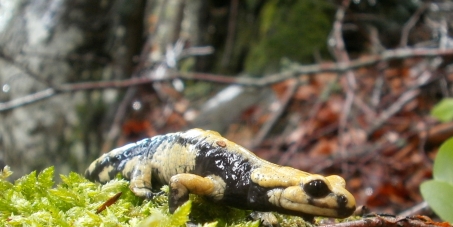
Save the golden Alpine salamander!
Described in 1982 as new taxon, the golden Alpine salamander (Salamandra atra aurorae) was one of the most unexpected and spectacular herpetological discoveries for the European continent of the last century (Figure 1). These unique salamanders are endemic to a very small mountainous area located in the southern Alps of Northern Italy, and are only known from a few localities in the Altopiano dei Sette Comuni (province of Vicenza, Veneto region) and the Altopiano di Vezzena (province of Trento). Populations of the golden Alpine salamander are geographically isolated from the remaining populations of conspecific Alpine salamanders (S. atra atra) and underwent a unique evolutionary history. Golden Alpine salamanders display remarkable differences concerning colour pattern and genetic composition with regard to other populations of Salamandra atra. In particular, while known populations of S. atra atra are uniformly black, the golden Alpine salamander always displays yellow patches on their dorsal side. Until today, S. atra aurorae has been only reported from a rather limited number of localities and currently it is not clear whether these sites are connected via dispersal/gene flow with each other. In contrast to populations of Salamandra atra atra, the golden Alpine salamander is considered to be critically endangered by the IUCN red list under criterion B1ab (iii) (http://www.iucnredlist.org/details/19843/0) and is included as “priority taxon” in the European Union Habitat directive due to its very limited geographic distribution and the potential threat of exploitation of its natural habitat through wood harvesting.
The Natura 2000 site "Altopiano dei Sette Comuni" is of major importance for the protection and conservation of existing populations of S. a. aurorae as it includes the area of the type locality of this taxon, the “Bosco del Dosso” forest. Until today, the population at the Bosco del Dosso is supposed to represent the largest known census size population of S. a. aurorae. Despite the enormous importance of this population, in May 2012 destructive forestry works as well as forestry clearings have been noticed at the Bosco del Dosso (Figure 2). Additionally, marked trees for later clearences were also observed (Figure 3). In detail, new forestry paths and roads were built by using heavy machines and a large number of trees, particularly Silver Firs ( Abies alba), have been marked to be cut in the near future. In the recent past, the use of heavy machines for wood harvesting, both in this and other similar areas, have had disastrous consequences including direct killing of salamanders, intense soil compacting, destruction of the forest understory and of small forest elements (e.g. logs) that are frequently used by salamanders as shelters during their activity period. Intended logging will have dramatic negative consequences for the habitat of the salamanders as the microclimate will change, soil temperature will increase and humidity of the soil will decrease. All in all, these effects will make the current environment of these salamanders unsuitable and it is very likely that this population will go extinct as a consequence of already performed and planned logging measures. Similar activities and heavy forestry exploitation are also currently ongoing at a second locality where the golden salamander occurs, the “Altopiano di Vezzena” highland.
The spontaneous protest of herpetologists and some politicians have temporarily stopped the forestry activities in the Bosco del Dosso. However, the threat for salamanders at the Bosco del Dosso is far from being banned and a new plan for the exploitation of the forest is going to be approved by local authorities in the course of the next months. In our view, minimizing the impacts of wood harvesting in the area of the Bosco del Dosso and other sites where the golden Alpine Salamander is found is a must for the future survival and conservation of this endemic salamander species. For this reason, the Societas Europaea Herpetologica (SHE), the Societas Herpetologica Italica (SHI), the International Society for the Study and Conservation of the Amphibians (ISSCA) and the IUCN Amphibian Specialist Group (IUCN ASG) have placed an open petition for the conservation of the golden Alpine salamander and its habitat in the face of this dramatic threat. We demand:
- Any plans for forestry management and exploitation should be developed urgently for all areas inhabited by S. atra aurorae (between Altopiano di Vezzena in Trento Province and the part of Altopiano dei Sette Comuni under Asiago and Gallio municipalities) in close cooperation with expert herpetologists, that should be recruited from the above mentioned societies, to avoid any negative impact on these salamander populations
- Logging and related activities impacting on salamanders and their habitat should be banned temporarily in areas inhabited by the golden Alpine salamanders until new and adequate plans for forestry management and exploitation will be endorsed